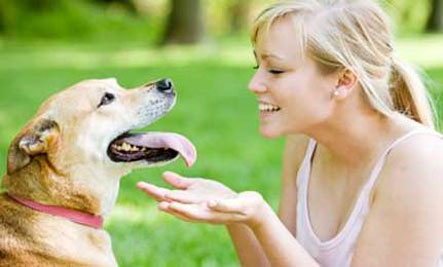There is probably not a pet owner out there that doesn’t wish, at one time or another, that they could communicate with their favorite animal. It has always been somewhat of a science fiction or fantasy scenario in which actually talking to a pet is possible, yet dogs can and often do communicate in other ways. They may not be using words but research has shown that dogs have a few very specific ways of conveying their wants, needs, and moods.
Dog Body Language Around Humans
The four-legged residents of your household undoubtedly “speak” what is on their minds through the use of dog body language. Below are some common examples of this behavior:
• Eyes - When in a situation that your dog finds friendly or comfortable you will notice that their eyes become wide and seem to “brighten up.” In contrast, when they are scared or intimidated their pupils tend to get smaller and you can more easily see the whites of the eyes.
• Ears - Typically when a dog’s ears are pointed upward he is attentive and listening in a comfortable state. When they are laid back even with the head then they are feeling submissive or anxious.
• Face - Dogs have been known to wrinkle their foreheads in order to convey confusion. A stretching of the forehead skin can signal that the dog is determined and has his mind set on a task.
• Tail - This is perhaps one of the most well known examples of dog body language. However, a wagging tail does not always indicate complete happiness. A tail wagging to the right indicates the usual positive emotions associated with this action while a left wagging tail has been known to indicate more of a negative feeling on your dog’s part. A straight out or down tail can indicate submission or aggression.
• Mouth - Have you ever caught your dog smiling? This action is common and occurs when the dog pulls their lips back and show their teeth in a friendly way. This indicates that the dog is content and would like to play. The showing of teeth in a wide open mouth position while growling or snarling is most definitely a sign that the dog is riled up and being protective or aggressive.
Dog Body Language Around Other Dogs
Dog body language around you as an owner can tell you a lot about your pet’s current disposition but so can the way they communicate with other dogs. Dogs are generally considered social mammals and they all follow a certain protocol when communicating with one another. Let’s take a look at a few of the ways dogs “talk” to one another and what we can learn from these actions.
• Rearing Hind Legs - When dogs rear up on their hind legs, it’s a sign of affection. It often looks like dancing when dogs do this together when they’re playing. When dogs are interacting with each other, in the dog park or outside on the lawn, you may have noticed how they tend to hop up on their back legs and almost try to hug each other or wrestle. This is an accepted indicator of affection and playfulness.
• Play Bow - This occurs when a dog lowers their front legs and puts their head down closer to the ground when around another dog. This normally means that they are asking permission to play. It can also signify an apology if the dogs has been playing too roughly.
• Biting - Non-painful or playful biting is harmless and is an enjoyable thing that dogs typically do when they are goofing around together. They are careful to avoid sensitive areas and control the strength of their bite. More serious or ferocious biting or nipping can show signs of aggression and indicate a problem between dogs.
• Paw Slap - This action is comparable to a human pat on the back or shoulder. By putting themselves in a somewhat vulnerable position the dog is showing that he trusts the other dog and considers them friendly.
Communication Goes Two Ways
When we are attempting to train our dogs to understand our commands and desires it takes time and patience. Sometimes we even require the assistance of a professional trainer or obedience school. But that is just part of the equation.
 | It is equally important to be able to understand your dog and what they may need from you. Using dog body language they try and show us the best they can. In order to forge better relationships with our pets it is important to be aware of what they are trying to tell us in the only way they know how to communicate, through their actions and movements. |
| Russ Barker can tell a dog likes him when they lick his face but was curious as to what other things could be gathered from dog body language, which lead to a little fact finding in order to create an interesting blog article. Russ is the editor for the Dog Tag Art Dog Blog. DogTagArt.com is an institution whose goal is to encourage pet owners to outfit their animals with pet ID tags. They offer beautiful full-color custom dog tags as an interesting way to promote pet safety and responsibility and help speed up the return of lost pets all over the world. |  |

